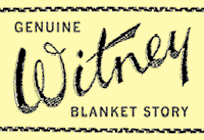Blanket language and art
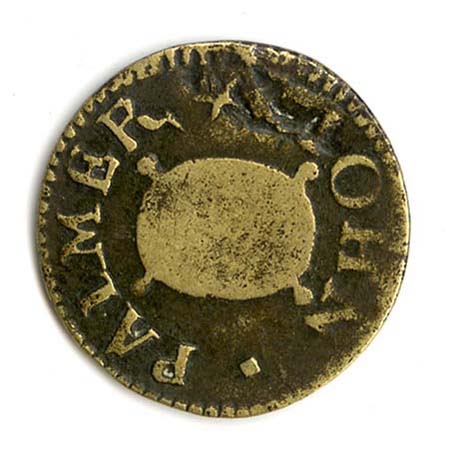 A 17th century Witney trade token featuring a wool sack,
evidence of the importance of the wool trade to the town.
Family names
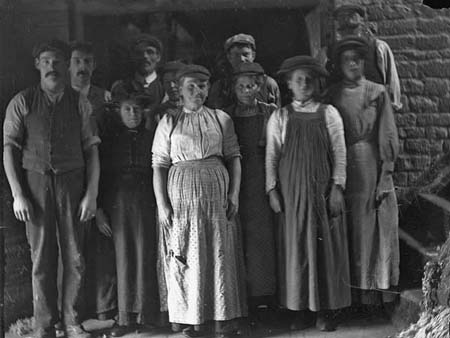 A group of late Victorian or Edwardian Witney blanket workers.
Many were probably closely related.
Here are just a few of the families that do not have 'wool' names but can nonetheless trace a long involvement with making Witney blankets through the generations: Buckingham, Collier, Early, Empson, Godfrey, Haley, Marriott, Parsons, Pratley, Smith, Wright.
Blanket making words
Here are some words associated with the blanket industry; some of them are unique to Witney. Do you know of any other words particularly associated with making blankets in Witney?
- 'blower' - Early's name for a steam-heated tenter or stenter, a
machine for drying cloth.
- 'cornering' - the ends of each blanket were sometimes marked by
'cornering', especially during the 18th century. Blankets were
woven in long, uncut pieces known as 'stockfuls'. A design such
as a crown (or in the case of Witney, a 'rosed' or 'roses'
design) was embroidered in a coloured worsted yarn onto what was
the intended corner on the ends of each uncut blanket piece.
- 'duffle' - a heavy blanket-type cloth with a close thick nap,
usually striped in bright colours. They developed into 'point
blankets'.
- 'flop' - a Witney word for a good accumulation of morning dew.
Witney tuckers believed that this gave blankets the best finish
and would hope for a good 'flop'.
- 'forrel' - the last 4 to 6 feet of blanket at the ends of a
stockful damaged by stitching during processing.
- 'fosset' - bobbins on to which weft is spun for use in a
shuttle. The name seems to be local to Witney as elsewhere in
Britain 'pirn' or 'cop' was the usual term. David Smith suggests
the following derivation:
'By chance I have found the origin of the name. I have an 18th
century cookery book by the famous Hannah Glasse, and in her
recipe for Birch Wine she tells one to 'bore holes in the body
of the tree, and put in fossets, which are made of elder
branches, the pith being taken out...' So fosset = faucet, and
of course elder twigs would do just as well for weft bobbins.'
[1]
- 'lace' - the border or stripes woven into ends of blankets.
Usually the stripes were blue, which made the blankets look
whiter. As well as being decorative, the laces were at one time
also a method of marking the position where a stockful of cloth
was to be cut into individual blankets.
- 'live horse, dead horse' - at Early's a method of saving wages
or paying advances to piece workers to standardise their wage.
- 'point' - a stripe woven into one edge of a 'point blanket', a
well-made heavyweight blanket made from coarse wool. Points
indicated the quality of the blanket, which came in point and
half-point sizes up to six points. Originally each point was
worth a good quality male beaver pelt.
- 'quill' - a bobbin for use in a handloom shuttle. Handloom
weavers paid children to 'quill' for them, that is, to wind yarn
onto the bobbins. This word may be unique to Witney; it survived
into the industrial age, when rewinding machine-wound bobbins
that had come unwound was still known as 'quill winding' or
'quilling'.
- 'rowing' - raising the nap on blankets. In Witney it is
pronounced to sound like 'ploughing'.
- 'stockful' - a length of woven blanket material before it was
cut up into individual blankets. A stockful was so-called
because it filled the bowl of a pair of fulling stocks, which
were used to clean and improve the texture of the cloth.
- 'tabbing' - to fix a label or tab on the corner of a blanket; a
'tabber' was the girl that sewed on the tabs.
- 'wadmill' - a rough woollen cloth mainly used for lining leather
horse collars. Also known as 'wadnal' or 'wednel'. A Witney
speciality.
- 'whipping' - sewing the edges of the finished blanket together,
usually with worsted thread.
Blankets on film
Over the years Witney blanket making has been the subject of many photographs and films. Charles Early and Co. employed the Oxford photographer Henry Taunt to take a series of photographs of each stage of the production process in 1898. They were used to illustrate a promotional booklet, and can be seen today on the English Heritage 'Viewfinder' website.
In the 1920s Pathé News made a silent documentary-style film about the making of Smith and Philips' 'Witnedown' brand blankets, which was shot at Bridge Street and Crawley Mills. Copies of the film are still in circulation.
 Norman Wisdom in the weaving shed at Witney Mill (copyright
Lawrence Dixey).
In a rather different vein 'There was a Crooked Sixpence', a 1950s Norman Wisdom film, was partly shot at Early's Witney Mill; in one scene Norman hurtles out of a shoot into a pile of yarn! The factory was not closed during filming and staff were present.
Witney blankets in verse and song
Several Witney products became famous enough to be celebrated in popular songs and poems. John Gay, the author of 'The Beggar's Opera', makes a reference to the water resistant qualities of unscoured Witney cloth ( a kind of coarse woollen material containing a proportion of grease that was used to make cloaks, wagon awnings, barge covers and horse rugs) in his 1716 poem 'Trivia: or the Art of Walking the Streets of London':
Nor should it prove thy less important Care,
To chuse a proper
Coat for Winter's Wear.
Now in thy trunk thy Doily Habit fold,
The Silken drugget ill can fence the Cold;
The Frieze's
spongy Nap is soaked with Rain,
And Show'rs soon drench the
Camlet's cockled grain,
True Witney Broad-cloth with its Shag
unshorn,
Unpierc'd is in the lashing Tempest worn;
Be this
the Horse-man's Fence; for who would wear
Amid the Town the
spoils of Russia's Bear?
In 1774 the poet Henry James Pye wrote in his poem 'Faringdon Hill':
To farther distance now the prospect drawn
Lo! Witney's spire
diversifies the lawn!
Whose busy loom to balmy sleep supplies
A guard from wintry cold and freezing skies.
Wonderfully Curious - the Witney Tuckers' song
Joseph Fowler was the composer of 'Wonderfully Curious', the Witney tuckers' song. He was himself a tucker in the Witney blanket industry who worked at West End Mill and is thought to have been born around the time of the Battle of Waterloo (1815). The song was sung by him at the annual Tuckers' Feast held on Shrove Tuesday, which was a very old custom in the town. John Seacole, Fred Middleton, Jack Tooley and Cyril Nunn followed him in singing the song in succeeding generations. They sang the verses, with the tuckers joining in the choruses. The song was last performed in the 1980s, when the Feasts came to an end.
To hear the song, go to 'Search the Collections' and search for 'sound recording'.
Wonderfully Curious
The wondrous globe on which we live
Is quite surrounded
everywhere
With something quite invisible
It's called the
atmospheric air.
The air is fluid light and thin,
Which
forms of gas it does combine:
It Carries sound in order well
When put in motion it is wind.
Chorus:
Oh! How curious, wonderfully curious,
The laws of nature are
indeed
Most wonderfully curious.
The wondrous globe on which we live
The seaman spreads his
canvas sail
And as it moves on quick or slow
He calls it
breeze, or storm, or gale.
But when it blows with so much
power
Till all resistance is in vain
Blowing at 80 miles an
hour
He calls it then a hurricane.
Chorus
The winds, the seas, the tempest blown
Are very changeable
indeed...
But in the torrids they are known
One way for six
months doth proceed,
Oft does the wind make ruins lie,
But
their usefulness has been understood,
For in the Bible we are
told
God guides the wind and rules the flood.
Chorus
Place names
The names of towns, villages and streets can also provide evidence of past connections with the wool trade. There are several places in Oxfordshire with a 'sheep' element to their name such as Shipton (meaning sheep town), Shiplake (the stream where sheep were washed), Shifford (the sheep ford). The towns of Bicester and Burford both have Sheep Streets.
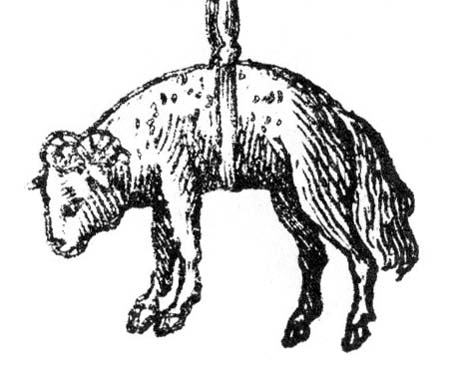 Illustration from an 18th century book showing the sign of the
golden fleece, often used on pub signs.
Phrases
Here are some common phrases in every day use that entered the language at a time when spinning wheels, looms and fields full of tenter racks for drying cloth were common sights:
- 'dyed in the wool' meaning an unchangeable person or a stalwart
(cloth which was dyed in the wool - i.e. the wool was dyed
before it was woven - had the most permanent dye)
-
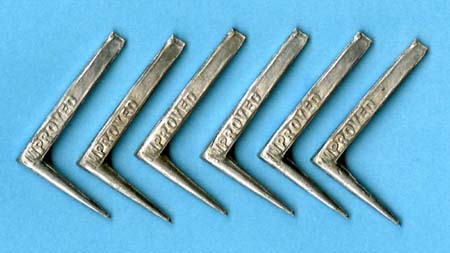 Tenterhooks.
- 'pull the wool over someone's eyes' meaning to deceive or
mislead someone
- 'spinning a yarn' meaning to tell a story, to lie, or embroider
a story
- 'web of lies' meaning a complex series of lies
- 'wool gathering' to be absent minded
- 'woolly' to be vague or confused
|
